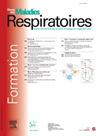Modeling COPD with a complex tubular model of distal airways integrating the epithelial and mesenchymal compartments
IF 0.5
4区 医学
Q4 RESPIRATORY SYSTEM
引用次数: 0
Abstract
Chronic Obstructive Pulmonary Disease (COPD) is characterized by progressive irreversible limitation of expiratory airflow, primarily affecting distal airways, which show early signs of remodelling, inflammation and obliteration. The limited relevance of 2D cell models and lack of 3D models mimicking small airway features hinder early pathophysiological understanding and drug discovery. We have previously developed a 3D mesenchyme-free “bronchioid” model using an innovative tubuloid cell-based assay and human bronchial epithelial adult stem cells derived from clinical samples [1]. Here, we aimed at integrating mesenchymal cells into the bronchioid model to investigate epithelial-mesenchymal interactions and their role in COPD development. Fine-tuning the composition of the scaffold is required to obtain a bronchioid with mesenchymal cells. Epithelial and mesenchymal cells were viable and organized from lumen to periphery, akin to bronchial topology. Adding this mesenchymal component improved the robustness of the system, highlighting their pivotal role in adhesion and contraction balance. Flow cytometry analysis and 3D imaging shows interactions between both compartments, strongly affecting epithelial differentiation. We conclude that the bi-component bronchioid enables modeling of the distal lung's epithelial–mesenchymal unit and represents a powerful tool for a comprehensive grasp of the disease processes in COPD.
用远端气道整合上皮和间质室的复杂管状模型建模COPD
慢性阻塞性肺疾病(COPD)以呼气气流进行性不可逆限制为特征,主要影响远端气道,早期表现为重塑、炎症和闭塞。2D细胞模型的有限相关性和缺乏模拟小气道特征的3D模型阻碍了早期病理生理学的理解和药物的发现。我们之前已经开发了一个3D无间质“细支气管”模型,使用了一种创新的基于小管细胞的检测方法和来源于临床样本[1]的人支气管上皮成体干细胞。在这里,我们旨在将间充质细胞整合到细支气管模型中,以研究上皮-间充质相互作用及其在COPD发展中的作用。需要对支架的组成进行微调,以获得具有间充质细胞的细支气管。上皮细胞和间充质细胞存活,从管腔到外周组织有序,类似于支气管拓扑结构。添加这种间质成分提高了系统的稳健性,突出了它们在粘附和收缩平衡中的关键作用。流式细胞术分析和3D成像显示这两个区室之间的相互作用,强烈影响上皮分化。我们得出的结论是,双组分细支气管能够模拟远端肺上皮间质单位,并代表了全面掌握COPD疾病过程的有力工具。
本文章由计算机程序翻译,如有差异,请以英文原文为准。
求助全文
约1分钟内获得全文
求助全文
来源期刊

Revue des maladies respiratoires
医学-呼吸系统
CiteScore
1.10
自引率
16.70%
发文量
168
审稿时长
4-8 weeks
期刊介绍:
La Revue des Maladies Respiratoires est l''organe officiel d''expression scientifique de la Société de Pneumologie de Langue Française (SPLF). Il s''agit d''un média professionnel francophone, à vocation internationale et accessible ici.
La Revue des Maladies Respiratoires est un outil de formation professionnelle post-universitaire pour l''ensemble de la communauté pneumologique francophone. Elle publie sur son site différentes variétés d''articles scientifiques concernant la Pneumologie :
- Editoriaux,
- Articles originaux,
- Revues générales,
- Articles de synthèses,
- Recommandations d''experts et textes de consensus,
- Séries thématiques,
- Cas cliniques,
- Articles « images et diagnostics »,
- Fiches techniques,
- Lettres à la rédaction.
 求助内容:
求助内容: 应助结果提醒方式:
应助结果提醒方式:


